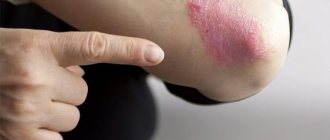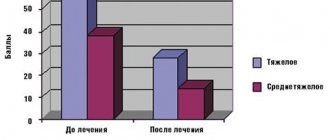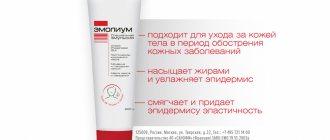In what cases are non-hormonal drugs used?
Drugs in this category have almost no contraindications and can be used for a long time. Among the most effective are the following:
- panthenol-containing – moisturize the skin, promote the healing of microcracks and minor damage;
- lanolin-containing – soften the skin, relieve pain and irritation;
- retinol-containing – stimulate skin regeneration processes;
- ointments containing local antihistamines are prescribed for insect bites and severe skin irritation.
Treatment methods
Treatment of dermatitis occurs under the guidance of a dermatologist and allergist. If it is difficult to establish a diagnosis or there are not only dermatological problems, the patient may be additionally referred to other specialists, for example, to a gastroenterologist.
Since atopic dermatitis is a complex disease, and it is caused not only by external but also internal factors, the treatment of this disease is not simple. Treatment for this disease is as follows:
1. Following a hypoallergenic diet. 2. Taking antihistamines. 3. Correction of disorders of the digestive tract. 4. Taking sedatives. 5. Taking vitamin complexes, vitamins B, A, E are especially important. 6. Antibiotics (erythromycin).
To soften the skin, ointments and creams containing corticosteroids and keratoplasty ointments with tar are used. Physiotherapeutic procedures such as reflexology, UV irradiation, etc. are also effective. Patients with chronic atopic dermatitis benefit from the dry sea climate.
Treatment of seborrheic dermatitis
Seborrheic dermatitis is a chronic disease that requires long-term maintenance treatment. Corticosteroids are used for this, but they can provoke skin atrophy. Many patients benefit from UV radiation, so improvement is often observed during the warmer months. The following can also be used in therapy:
• For the scalp, shampoos containing tar, selenium sulfide, zinc, and ketoconazole are used. When washing your hair, the resulting foam is applied to the affected areas of the body. Corticosteroids are also used. • When weeping between skin folds, Castellani liquid is effective. • For treatment on the face and other parts of the body, use 2% ketoconazole (cream) and corticosteroids - hydrocortisone acetate 1 or 2.5%.
Treatment of allergic dermatitis
Treatment of allergic dermatitis is primarily aimed at eliminating the action of the allergen, sometimes after which the skin manifestations of the disease disappear on their own. But most often, therapeutic measures are also required for a complete cure. These include:
1. External therapy with anti-inflammatory drugs - ointments containing corticosteroids, wet-dry dressings, treatment with drying agents - hydrogen peroxide, potassium permanganate (potassium permanganate). 2. In case of severe disease and a very pronounced clinical picture, desensitizing agents are used intravenously. In addition, sedatives and antihistamines may be prescribed.
Treatment of perioral dermatitis
The very first thing to do when perioral dermatitis occurs is to stop using any cosmetics, creams and ointments. It is especially important not to use corticosteroids at this time. It is necessary to limit the mechanical impact on the skin - after washing, only lightly blot your face, but do not rub.
In the early stages, indifferent powders and cooling creams are prescribed for the treatment of perioral dermatitis. In parallel, a dermatologist or allergist may prescribe antihistamines. Antibiotics (erythromycin) have shown good effectiveness for the treatment of this type of dermatitis.
Unlike other types of this disease, perioral dermatitis is aggravated when the affected area is exposed to direct UV rays, so patients need to limit their exposure to the sun, and in the summer, for prevention, use sunscreen with the highest protection factor.
Prevention of dermatitis
To prevent dermatitis from having to be treated or becoming chronic, it is better to prevent this unpleasant disease. Prevention consists of following safety precautions at work and at home. You need to use chemicals with caution, do not expose your skin to high and low temperatures, and be careful with certain types of plants.
It will help to avoid allergic dermatitis by not affecting the body with various allergens that can cause skin reactions. Following a proper diet will help prevent atopic dermatitis.
Despite the fact that many patients prefer self-medication to visiting a dermatologist, it is still better to seek qualified medical help. A simple form of dermatitis can go away on its own, but incorrect treatment of allergic or atopic dermatitis can only aggravate the patient’s condition.
Who are hormonal medications indicated for?
Ointments containing corticosteroid hormones are prescribed in allergy clinics only according to strict indications. Penetrating into the blood, the substances inhibit the function of the adrenal glands. Even new generation drugs, in which side effects are minimized, lead to dryness, thinning and atrophy of the skin, active hair growth, the appearance of stretch marks and acne. They can be used for up to 10-12 weeks for adults and no more than 3-4 weeks for children.
Most often prescribed:
- flucinar - a glucocorticoid in the form of an ointment or gel to relieve inflammation in urticaria;
- hydrocortisone ointment - for eczema, psoriasis, dermatitis;
- advantan - especially effective for weeping allergic dermatitis, including among children from 4 months;
- elocom is a new generation drug that has virtually no systemic side effects.
Along with mono-drugs, there are also combination drugs, which include corticosteroids, antifungal and antibacterial agents. They are prescribed for secondary infection or when the risk of complications is high. Due to the wide variety of remedies, you should not self-medicate local manifestations of allergies: many drugs are not as harmless as they might seem. In addition, local treatment will only be effective in combination with systemic treatment - against the backdrop of hypoallergenic living conditions.
Review of remedies for atopic dermatitis
What products should be used to combat atopic dermatitis?
Anna Trushina, a dermatologist at the DocDeti clinic, will talk about the means used to treat and prevent atopic dermatitis.
Atopic dermatitis is a chronic inflammatory skin disease. And to treat it, you need products for external use that affect the skin.
What medications are there?
For basic, permanent therapy, products with emollients are used. Such products are aimed at prevention and help relieve exacerbations.
Emollients soften, moisturize the skin, and replenish its barrier function. They increase the effectiveness of anti-inflammatory therapy, resist itching, skin soreness and eliminate flaking.
Release forms:
- Lotion and milk are the lightest form. They apply well in a thin layer, but the moisturizing effect is minimal. The product can be applied to hairy areas of the skin and to areas of acute inflammation.
- Creams are denser products than milk and lotions, but they are also comfortable to use. They can be used throughout the day - there will be no greasy residue left.
- Ointments and balms are the thickest and densest forms, good for very dry skin, thickened skin, with severe peeling, as well as for nighttime care.
What's within your means?
There is a large selection of available emollients on the market: La roche posay Lipikar, Bioderma Atoderm, Uriage Xemose, Topicrem DA, A-derma Exomega, Avene Xerocalm, Noreva Xerodiane, Emolium, Atopic, Cerave, Eucerin and many other products.
Something more serious
In case of exacerbation and the appearance of foci of inflammation, the doctor may prescribe reparants
- they speed up healing and relieve irritation. Products are used only in problem areas, and not on the entire skin. They do not replace products with emollients!
There are two forms of release of reparants; liquid lotion and balm or cream. It is not difficult to find these drugs in pharmacies - most contain Cica in their names.
Liquid medications help relieve inflammation and are often prescribed in a short course. These are Avene Cicalfate lotions, Bioderma Cicabio and Uriage Bariederm Cica spray.
Reparants in the form of creams and balms are used if necessary: A-derma dermalibur, La roche posay Cicaplast, Topicrem Cica, Avene Cicalfate (in the form of cream), Bioderma Cicabio (in the form of cream), Uriage Bariederm Cica (in the form of cream).
Nothing helps
There are cases when emollients and reparants cannot cope, then drug therapy comes to the rescue (prescribed by a dermatologist!).
1. topical glucocorticosteroids (hormones)
A large number of studies have confirmed that the drugs are effective and not dangerous when used externally. But remember that the attending physician must monitor the process.
GCS differ greatly from each other in terms of active substances, form and form of release of products (emulsions, creams, ointments, sprays, and so on).
2. calcineurin inhibitors - pimecrolimus and tacrolimus
Group of anti-inflammatory drugs. These are non-hormonal products that can help in delicate areas: facial skin, diaper area, folds - where the use of hormonal products is limited. These drugs are also suitable for long-term therapy.
3. antibiotic, antifungal drug
Prescribed alone or in combination with other medications if a complication occurs due to a secondary infection.
Additionally
The doctor may recommend syndets - products that cleanse the skin when bathing; they replace shower gel and soap.
Stop list
The pharmacy offers a wide selection of tar, ichthyol, and naphthalene preparations, but it is important to know that they are not treatments for atopic dermatitis.
Allergic dermatitis cream
This form of the disease occurs as a result of human contact with an allergen - chemical, food, drug, etc. The disease is characterized by dry and itchy skin, the appearance of flaky, reddened areas, and the formation of papules and blisters. Most often, the rashes are localized on the hands and face.
Treatment involves stopping contact with the allergen and using antihistamines. As for the choice of cream for dermatitis on the hands and face, it depends on the intensity of the symptoms, age and general health of the patient. For mild forms of the disease, remedies based on string, chamomile, violet, menthol, and ichthyol are prescribed. The use of calcineurin inhibitors may also be recommended. If we are talking about a severe form of allergic dermatitis, the use of methylprednisolone aceponate, hydrocortisone acetate, betamethasone dipropionate may be required.
Seborrheic dermatitis cream
Seborrheic dermatitis usually affects areas of the body that have a large number of sebaceous glands. One of the most unpleasant signs of this type of disease is that it is often localized in exposed areas of the body. This causes a person not only physical, but also psychological discomfort. Therefore, it is very important to pay special attention to choosing a suitable cream for seborrheic dermatitis on the face (especially in the nasolabial triangle), scalp, neck and other affected areas.
The cause of seborrheic dermatitis is infection of the skin by yeast-like fungi Malassezia, so external antimycotics (antifungal drugs) are prescribed to combat the disease. For treatment, external agents based on ketoconazole, fluconazole, and clotrimazole are used. Another task, in addition to normalizing the skin microflora, is to ensure rapid exfoliation of scales and normalization of sebum (sebum) production.
Clinical researches
La-Cri creams for sensitive skin and La-Cri cream for dry skin are recommended by the St. Petersburg branch of the Union of Pediatricians of Russia.
The conducted clinical study proves the high efficiency, safety and tolerability of products for daily skin care of children with mild and moderate forms of atopic dermatitis and during remission, accompanied by a decrease in the quality of life of patients. As a result of therapy, a decrease in the activity of the inflammatory process, a decrease in dryness, itching and flaking was noted.
Sources:
- Tulchinskaya, V.D. Nursing assistance to children / V.D. Tulchinskaya. — Moscow: Russian State University for the Humanities, 2016.
- Andropova T.V., Gudina M.V., Odintsova I.N., Hygiene of children and adolescents, Siberian State Medical University Publishing House, 2022.
- Reken Martin, Schaller Martin, Sattler Elke, Burgdorf Walter, Atlas of Dermatology, MEDpress-inform, 2022.
Photos of dermatitis
Photo album on the diseasePrevalence of atopic dermatitis in children
It is safe to say that this disease can occur in any country, in both males and females. Dermatitis occurs in different age categories. The prevalence of AD is higher in residents of economically developed countries, which may be due to the urban lifestyle of this population. According to the protocol for the treatment of AD in children, the prevalence of this pathology in the Russian Federation ranges from 6 to 15% according to ISSAC. ISAAC is a standardized epidemiological study - the International Study of Asthma and Allergy in Childhood. Repeated studies within the framework of this program show a significant increase in the prevalence of AD in children of the Russian Federation.
Research shows a significant increase in the prevalence of atopic dermatitis in children in the Russian Federation.
Also, the expert committee on asthma and allergy of the WHO European Bureau developed and approved another program - GA2LEN. GA2LEN (Global Allergy and Asthma European Network) studied the incidence of allergic pathology among adolescents aged 15 to 18 years. According to the study, the presence of symptoms of AD occurred in 33% of adolescents, the prevalence of AD according to questionnaires was 10%, and a confirmed diagnosis was found in 7% of adolescents. Girls have 1.5 times more than boys.
La-Cri is your assistant in the prevention of dermatitis
La-Cri's non-hormonal products, made from natural, safe ingredients, are excellent for accelerating recovery and preventing this disease. For example, there are many positive reviews about the use of La Cree cream for dermatitis. The active components included in the La-Cri cream for dry skin provide delicate care for damaged skin:
- Natural hypoallergenic oils (wheat germ, jojoba and shea) provide skin nutrition, combat dryness and normalize water-lipid balance.
- Plant extracts (licorice and string) help cope with itching, redness and flaking.
- Beeswax perfectly softens and nourishes the skin.





